For a recent panel discussion on the topic of health tech and innovation for the future, we were joined by a panel of experts and digital leaders from across health and care, who shared their perspectives and insights around fostering a culture of innovation, overcoming challenges, nurturing ideas, and more.
Joining us to share their views were Dr Penny Kechagioglou, chief clinical information officer and deputy chief medical officer at University Hospitals Coventry and Warwickshire (UHCW); James Driver, digital innovation manager at Buckinghamshire, Oxfordshire and Berkshire West (BOB) ICB; and Dan Johnston, associate CNIO and director of clinical operations for Imprivata.
Panel introductions and key projects around innovation
Penny noted the timeliness of this discussion around innovation given the recent publication of the Darzi report, before kicking us off with the introductions, highlighting UHCW’s EPR go-live six months ago, and sharing that the organisation is currently looking at how it can introduce automated pathways, and developing its patient portal capabilities around two-way messaging between patients and clinicians.
“We’ve been quite novel when it comes to AI,” Penny said, “working with industry, working with clinicians, building our understanding of the pain points and the issues we’re trying to solve.” One way AI is currently being used is in improving pathways to outpatient clinics, she went on, “and through that simple change in the ways we communicate with patients, we saw the DNA rate drop significantly, and we’re seeing around 700 more patients per week in our outpatient clinics.”
UHCW is also employing chat bots to deal with common patient queries via its website, which Penny shares has helped to significantly reduce the volume of calls the hospital receives, “so we can deal with other patient needs or areas of patient care that are more pressing.”
Dan shared how alongside his role with Imprivata, he is a practicing emergency nurse, saying, “I use that background to be the clinical safety officer and evaluate Imprivata’s technologies at the point of care for the difference they’re making for patient care and for clinician workflows.”
The type of technology he primarily works with is identity access management, Dan summarised, “but what that means in simple terms is rapid secure access to patient information”. The “large part of that”, he told us, “is looking at what that technology can actually achieve, creating learning healthcare systems, and working with organisations to look at the problem they want to solve, optimisation, analytics, and creating agile workflows.”
James highlighted how his role sees him working closely with primary care networks, “looking at how practices can work better within those networks, and facilitating those best models of care.” That includes neighbourhood models, and how they can aggregate their data into the local Shared Care Record, “which in terms of innovation means disseminating and consolidating best practice for solutions, as well as facilitating uptake of ideas from NHSE around how practices can enable the population health model.”
Some of those ideas and innovative ways of working have included PCN hub working models, James went on, and “how they can integrate things like e-consultations”. Key issues are around demand and capacity, he said, “and for practices, they need to deal with increased demand on the telephone, whilst still dealing with walk-ins, and moving toward more effective means of digital triage.”
At BOB ICB, James said one focus has been on robotic process automation (RPA), and “how that can work in practices”, supported by NHSE funding, “running a number of pilots to see how to best implement that”. This work has taken more of a “grass roots” approach, according to James, “just seeing how practices get on with that. It’s a new area in primary care in particular, but there’s a lot of interest there, and some of our projects there have gone quite successfully, some less so; we’re looking at incorporating that learning and how we can take that forward.”
Fostering a culture of innovation
Picking up on a key theme of the Darzi report around fostering a culture of innovation, Penny told us how a “whole organisation or whole system response” is key to how we address innovation, “because a lot of the time innovation is happening in siloes; we launch something and then don’t evaluate it enough, share learnings, or scale.” At UHCW a quality improvement methodology, “which links closely with continuous innovation”, helps ensure “innovation is in our DNA; our people have the space and the time to think about ideas and what small changes we can introduce to improve the outcomes in our everyday tasks.”
The first step in that is understanding those outcomes and the data produced, Penny went on, “along with any risks, and what our patients and staff are telling us.” When it comes to larger-scale innovations, she said, “doing more of the same is not going to change things, so we need to do and think differently; technology is there to enable us in that.” Getting the right stakeholders involved “so they can own that problem, solution, design”, is essential, she added.
Penny also shared details of an innovation challenge she’s currently leading at UHCW on digital consent, saying, “we’re opening up a lecture theatre to innovators to come and demonstrate how they can work together to give us a solution to a problem we have; that knowledge of how to do things makes the process of innovation faster, and makes the engagement with staff more effective. The time spent on it reduces, you achieve better outcomes, and then you repeat that for the next project. I think that’s how you learn and scale your innovations.”
“I’m very closely aligned with what Penny’s just outlined,” Dan said. “The idea of having a methodology, of measuring outcomes, of thinking in small steps toward a bigger goal – these all sound fairly obvious, but they’re difficult to do within an NHS-type culture.” In his experience working with different trusts, “it’s not unusual for any one of those steps not to be present”, he added, “especially around measuring the before-state, the after-state, and around engagement.”
That process is “not widely adhered to generally” across the wider NHS, Dan told us, “and whilst there’s lots of great intention, I think the pressures within the system make it difficult to adhere to.” Noting increasing commitment to improve this, he voiced hopes that the publication of reports such as the Darzi report would help with a “renewed focus” on making that happen. “It’s also about being really receptive about what’s going on, on the frontline – there’s tremendous amounts of innovation happening, but from the frontline experience, we’ve still got a step to go to make a marked impression at-scale.”
Getting technology to respond to frontline need, and helping frontline staff with day-to-day activities like processing and collecting blood samples “without printers malfunctioning on you”, or “having a device to help charting whilst you’re managing a confused patient”, is important, Dan said. “I do think frontline experience is key, and I do think there’s a gap that industry and suppliers could really step into in terms of bridging that gap, getting those frontline experiences, and being able to quantify them.”
James told us how BOB ICB likes to “offer practices the space to figure out what works for them”, sharing that the digital team runs forums and digital innovation groups to support and encourage the introduction of new ideas. “We’ve also had a community of interest forum, which is a more lateral practice-to-practice forum facilitated by the ICB, and we find that solutions coming out of that are things that work practically and quickly for practices, so it works quite organically.” It’s then up to practices to decide “the degree and extent to which they want to use that”, he added.
Certain solutions have “landed quite quickly”, according to James, especially around things like social prescribing, which help deal with capacity and demand pressures. “Also digital triage tools,” he noted, “where practices can direct patients to resources like the NHS app or local service, or bespoke apps which include chatbots capable of signposting to relevant services, or take initial information to help get them to the right place, or even book them an appointment slot.”
When it comes to RPA, “it’s good to have UK-based suppliers that understand the UK public sector”, James considered, “and one of the key lessons learned is around getting the governance in place quickly, especially when tools are being used in a clinical environment – taking the right steps around certification and privacy is essential.” Pathways such as COPD and diabetes are popular options, he went on, for the application of RPA search-finding tools “which can run on EMIS to pull patients out”.
Overcoming challenges around innovation in health and care
Penny acknowledged James’s point relating to getting governance in place early, highlighting that this approach ensures that priorities are discussed and processes are put in place to support the transition from idea to implementation, and then to evaluation. Noting that the lack of a standardised approach to this could be a challenge, she reflected on her role in leading the clinical safety aspect of UHCW’s EPR implementation, saying “I think we did this quite well, and therefore we can replicate that when looking at future innovations and how we engage with our vendors.”
Another challenge is around patient involvement, according to Penny. “I don’t think we involve them enough, and we need to look at how we engage patients early in the design thinking of the idea,” she said. When it comes to how those ideas are generated, “it’s usually by the people who are actually doing the work on the frontline, who can look at the data and understand where the problems are”, she continued, “but it’s important we offer them the space to do that”.
At UHCW, an innovation hub and a dedicated team help encourage people coming forward with ideas, and Penny also shared that the organisation runs “Dragon’s Den” type activities and events “to bring innovators, researchers and staff together to talk about what we have done, what we have learned, and what’s in the pipeline.”
“We’ve got some incredible technical innovation,” Dan said, “and it’s taking that and applying it to the patient context, ensuring the patient remains at the centre, which is still a mic-drop conversation to have at this point, because I think we’re still figuring out what it means to co-design, what it means to engage. It’s seen to be a nice-to-have, rather than an essential.”
Industry could make its technology “far more accessible to the frontline problems it’s looking to solve”, Dan considered, “and we’re still looking to cross that bridge from having a technology looking for a problem to solve, to a problem looking for a technology to solve, and I think industry has a role to play in that.” He pointed to an area of development for industry being around developing evidence and case studies to support clinician engagement, and to help organisations and decision makers to really get a feel of the impact of a technology.
“It’s almost as though we need to move through the fluff and get to some real methodology around this,” Dan said, “in order to be able to communicate that. I understand that as a system, money is critical, but I feel like the clinical ROI at the moment is seen very much in pounds and pence when it comes to the evaluation of technologies, and we need to develop a dual language around what it means for patient experience, clinician experience, quality, and ultimately safety.” Developing a common language and a common understanding is essential to innovating, Dan went on, “and I think that’s key for the industry when it comes to innovating in a really agile way.”
“I could probably relate all of those together,” said James, “and in terms of technology, it comes down to meeting an immediate need, particularly for the primary care space – if practices know it’s going to work quickly, then that almost organically becomes a solution.” From a strategic perspective, he observed, “whilst the clinical models for things like Modern General Practice are clear, there’s a gap when it comes to technology and where that fits.”
Whilst a top-down approach might not work, James considered, “there are advantages to that in terms of scalability and the value you gain in being able to procure at scale. We have a plethora of solutions across our ICB landscape, but that can lead to a certain amount of variability, and there hasn’t been a great deal of procurement guidance, so we’re looking to the new government to see if something changes on that. On an ICB level, when practices are asking for that guidance, it makes it difficult for us to make recommendations.”
James also noted that whilst larger and better-established companies might have an easier time of getting their innovations or technologies recognised in things like the GP IT catalogue, “because people know what they are”; more cutting-edge innovators and smaller start-ups “may have a good idea but you have a catch-22 situation with technology assessment criteria and governance” which prevents that innovation coming through. Whilst nothing specific springs to mind to rectify this, James added, “what probably has to happen is that at top level, we need to allow greater use of digital trials of things, and funding for that, to give those trials space to operate in a clinically safe environment.”
Highlighting upcoming innovation
Sharing his thoughts on upcoming innovation and the direction that might take, James talked about plans at BOB ICB to focus on and consolidate “things that have worked”, such as digital triage, which could be boosted by improved functionality planned for the NHS app. RPA is another area James noted as potentially upcoming, “with clearer guidelines for which products or apps that might work with or how that might work with GP systems.” James also talked about wanting to see clearer procurement guidelines “around what tools and technologies should be used, what type, and how ICBs can then scale that up for greater effectiveness and benefit across the health system.”
“I think we’ll continue to see conversation about ambient dictation, augmented reality, and precision medicine,” said Dan, “as well as how we can harness all of our data.” Referring to conversations he’s had with CNIOs and CCIOs, he said, “it’s about returning back to fundamentals and realising what we’ve already got.” Talking about how much work is still to be done when it comes to adopting what is already available and improving digital literacy, he noted: “I struggle at the best of times, and I feel like I’m thoroughly engaged, so I can’t imagine what that’s like for those who don’t have digital at front-and-centre.”
Reflecting on his work with Imprivata, James shared that priorities include figuring out “what people are using mobile for”, how to utilise analytics more effectively, and incorporating new technologies such as facial biometrics or biometric data, “as well as how we enable that information to support patient care or access to data.”
Penny agreed with Dan’s point about returning to fundamentals, saying, “we need to get the basics right and finish getting all healthcare records digitised.” On automation, Penny considered that “it’s going to have to improve our workflows, because there’s still a lot of administration to be done, and we need to simplify those workflows and have clinicians looking after patients rather than spending hours in admin.” This has been done successfully in other countries, she went on, “and I think that needs urgent attention.”
Interoperability is another key focus, Penny continued, “because there are a lot of technologies that don’t talk to each other, which probably create delays in the pathway, so we need to think about connectivity.” When it comes to left shift and prevention, she highlighted the potential of the NHS app, as well as digital tools designed to retrieve information from patients, digital triage, and other areas, “which are vital if we’re going to move forward in healthcare”.
We’d like to thank our panel for their time, and for sharing their insights and experience in this space with us.





